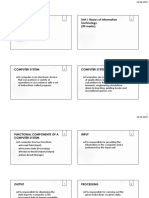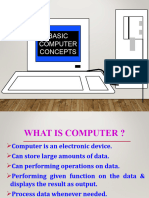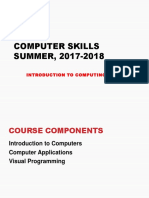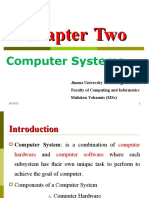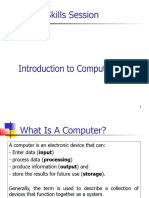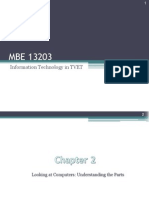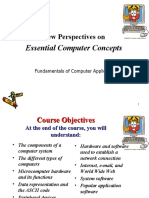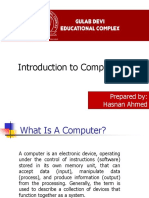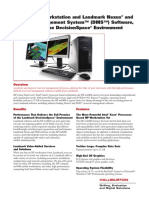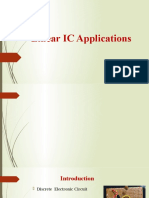Computers for
Managers
Computer systems
Basic Computer
operations
1
�What is
computer
Electronic
device used to
Benefits of
using
computers
store,
Speed
retrieve,
Accuracy
and
manipulate the data
Consistency
Storage
capacity
and
Flexibility
2
�History of Computers
Charles
Babbage - father of computer
1800s planned analytical engine
ENIAC
- developed at end of WW II
1951 - 1963 1st and 2nd generation
very large, used unreliable vacuum tubes
1963
- present - 3rd and 4th generation
smaller, faster - use transistors and integrated
circuits, VLSI(MICRO PROCESSER )
3
�The Basic Components
CONTROL
UNIT
ALU
INPUT UNIT
CPU
MEMORY
SYSTEM UNIT
OUTPUT UNIT
�Computer Operations
Block Diagram of Computer
Control
Input
Primary Storage
(RAM,ROM)
Output
CPU
External Storage
Hard disk, CD, Floppy, Magnetic tape, Pen drive
5
�Input devices:
Keyboard
Mouse
Scanner
Joystick
Output devices:
Monitor
Printer
Plotter
�Input Devices - Keyboard
Most
commonly used input device
Ergonomic
Special
(Primary input device)
- fit natural hand placement
keys
Enter, Function, Ctrl, Alt, Num Lock, Esc
�Input Devices - Mouse
Controls
cursor on
screen
May
be mechanical or
optical
Most
models have a
wheel for scrolling
Or Light sensing
8
�Input Devices - Other
Pointers (replaces mouse on notepads)
Track point, track ball, touch pad
Scanner
Digital
: Flatbed scanner, portable scanner.
camera
Touch
screen
Voice
: Microphone
9
�Output Devices
Monitor
Printer
Speaker
Disk
Drive
Can also be input device
Modem
Can also be input device
10
�Monitors
Made
up of tiny
elements called pixels
Each row of pixels is
called a scan line
Picture is displayed by
an electronic beam
lighting up certain
pixels
11
�Monitors - Resolution
Resolution
is how sharp and clear the
picture is
How
many scan lines on the screen
640 x 480 is low resolution
1600 x 1200 is high resolution
12
�Monitors - Sizes
Screen
measured diagonally
May also measure actual viewing area
14
or 15 on bargain systems
17
has become the standard
19
and 21 available but are more
expensive.
13
�Monitors - LCD
Liquid
Crystal Display
Similar to digital watch
Used for notebook computers
Also used in flat screen monitors
Much thinner than regular CRT monitor
More expensive than regular CRT monitor
14
�Monitors - Video Card
Processes
info to send to monitor
Amount of video memory may speed up
graphic intensive programs
32 megs general purpose
128 or more megs graphic intensive use
AGP port
can speed up graphics
3D accelerator card improves graphics
15
�Printers
Laser
Ink
Jet
Dot
Matrix
16
�Printers - Laser
Works
similar to a copy machine
Color printers available but more expensive
Fast,
quite, with excellent quality
More
expensive to buy and operate
Some
units scan, photocopy, and print
17
�Printers - Ink Jet
Spread
small jet of ink onto paper to form
characters
Replaced
dot matrix
Quiet
Does
good job on color
Good
quality and reliability
18
�Printers - Dot Matrix
Strikes
pins against ribbon to print
Comes
in 9 and 24 pin
Once
very popular
Now
replaced by ink jet and laser
19
�Printers - Speed
Measured
Laser
in pages per minute (PPM)
printers range from 20-45 ppm
Color printing is slower
20
�Printers - Quality of Print
One
measure is dots per inch (DPI)
300 dpi for general purpose uses
600 dpi for higher quality
1200 dpi for photo quality
May
have different vertical and horizontal
resolution
600 x 300
Other
factors can affect quality
21
�Storage Devices
Hard
Disk
Floppy Disk
Optical Disk
Compact Disk
Digital Versatile Disc
Pen Drive
Memory Card
Yet to come { ? }
22
�Floppy Disks
All systems now only have 3 1/2
HD
- High density - comes on all current
systems
3 1/2 - 1.44 megs
23
�Hard Disk
Built
into machine
Made up of stack of platters
Can store much more than floppy
drives
40 gigabytes should be minimum
Can
access info much faster than
floppy drive
24
�OPTICAL DISKS
Optical
disk use laser technology to Provide
high capacity storage.
CD & DVD is Optical disks
Todays standard is CD.
Tomorrows will be DVD.
Come in different speeds - 20x, - 50x
25
�COMPACT DISK (CD)
CD-ROM
: Which stands for compact discread only memory
CD-R
: Which stand for CD-recordable
CD-RW : Compact disc rewritable.
Allows you to write to both CD and DVD disk
Still somewhat expensive
26
�DIGITAL VERSATILE DISC
(DVD)
Digital
versatile Disk
Can
store up to 17 GB
Can
store full-length movies
Can
also read CD-ROM disk
27
�Storage Devices - Other
USB
drive (Pen drive)
Very popular 64 MB to 4 GB
Tape drive (magnetic tape)
Similar to cassette tape but outdated
Used for backup
Zip
drive ( higher capacity of floppy disk)
100 MB to 2 GB capacity
Everyday use and backup
28
�SYSTEM BOARD
The
system board also known as the main board or
motherboard.
All the components of the computer ie chips and
microprocessors are mounted on the motherboard.
Major ports for input and output as well as RAM
and processor are mounted on this board.
The system board connects all system components
and allows input and output devices to
communicate with the system unit.
29
�Central Processing Unit
CPU Also
Is
the brains of the computer
Performs
It
called processor or Microprocessor
all computer operations
has two basic components: Control Unit And
Arithmetic & Logical Unit
30
�Basic Processing Cycle
Central
Processing
Unit
Data
Bus
Internal
Memory
31
�Internal Memory - RAM
RAM
- Random Access Memory
CPU can access any location as quickly as any other
Temporary or volatile storage
Can
not only read current info but also write new info
Very
important in determining capabilities of the
computer system
Flash ram, Virtual memory,Ram cache.
32
�Internal Memory - ROM
ROM
- Read Only Memory
Can read info Stored in ROM
Can not write new info into ROM
Used
for internal workings of computer
Buyer
is not very concerned with ROM
33
�Internal Memory -CMOS
A complementary
metal-oxide semiconductor(CMOS)
It
contains essential information that is required every
time the computer system is turned on.
The
chip supplies such information as the amount of
Ram, type of keyboard, mouse, monitor, and disk
drives
It
power by battery so does not lose its contents when
power turned off.
34
�With this we end the basics of
computers.
Thank you.
- Sarang Javkhedkar
35
�Classification of Computers
Super Computer
Mainframe Computer
Minicomputer
Microcomputer
36
�Supercomputers
Most
powerful
Fastest
Most expensive
Several million dollars each
Used
only by
Governmental agencies
Large international corporations
37
�Mainframes
Very
powerful
Very
fast
Used
by large corporations and
governmental agencies (LIC)
Operated
by computer specialist
38
�Minicomputers
Size
of filing cabinet
Used
by small and medium size companies
and institutions
Operated
by computer specialist
Terminals
allow many people to use
39
�Microcomputer
Also
called Personal
Computer (PC) and
Desktop Computer
Available
in desktop size,
notebook size and
handheld (PDA)
Can
be IBM, IBM
Compatible or Apple
40
�History - Microcomputers
Apple
First sold in late 1970s
Developed by Jobs and Wozniak
IBM
Personal Computers
First sold in 1981
Was quickly accepted by businesses
IBM compatibles soon developed
41
�Software
&
Hardware
42
�SOFTWARE
Software is any set of instructions that tells the
hardware what to do. It is what guides the hardware and
tells it how to accomplish each task. Some examples of
software are web browsers, games, and word processors
such as Microsoft Word.
A general term for computer programs and
documentation involved in the operation of the
computer.
PROGRAMS A sequence of instructions directing a
computer to perform a particular function; a statement
of a algorithm in programming language.
DOS disk operating system
DATA 43
�Types of Software
Computer Software is the Programs that enable a
computer to perform a specific task.
System software
Application software
Embedded software
Scientific software
44
�Programs
Set
of instructions to the computer
Programming
languages
Machine language(lower level language)
Assembly language(medium level language)
Procedural languages(high level language)
Basic, Fortran, Cobol
4 GL(Object oriented languages)
Visual Basic, C++, C#, Java
45
�Systems Software
System
Software work with the application software to
handle the majority of technical details
System
Software consists of Operating system,
Utilities, device driver,and Language Translators.
Operating
system manage resources, provide a user
interface and run application
Examples
of systems software
DOS, Windows, Unix, Linux, MAC OS
46
�Applications Software
Helps
you to accomplish a certain task
Examples
Word processing - memos, reports, etc.
Spreadsheets - budgets, etc.
Database - search, sort, select data
Educational - simulations, practice
Graphics - charts, diagrams
Desktop publishing - pamphlets, etc.
47
�Embedded software
These
are a special breed of software which
are typically used to add functionality to the
existing software.
A small software or piece of code is added
to a software so that the overall
functionality of the software is increased.
This may be custom made or tailor made.
48
�Scientific software
These
are special purpose softwares which
are specially designed to enable scientists to
work better.
This softwares provide not only
computational capabilities but also logical
capabilities with the help of huge database
associated with them.
49
�Hardware
Hardware is any part of your computer that has a physical
structure, such as the computer monitor or keyboard.
The electronic circuits, memory and input / output components of
a computer system; the tangible objects.
MEMORY
RAM RAMDOM ACCESS MEMORY
ROM READ ONLY MEMORY
HARD DISK
CPU CENTRAL PROCESSING UNIT
MOTHERBOARD
MODEM
POWER SUPPLY
50
�Hardware vs. Software
Hardware
The computer equipment
Includes printers, monitors, disk drives, etc.
Software
Programs which tell the computer what to do
Examples - word processing, Microsoft excel,
Power point, games, etc.
51
�Expansion Slots
Allows
you to add capabilities
Example
of cards you can add
Network card
Modem
TV turner card
52
�Ports
Connects computer to another device
Parallel port
Used primarily by printers
Serial ports
Modem, mouse, etc.
USB may be needed for
Digital Cameras, Mp3 players, Other devices
53
�Controversy
It must be noted here that some
authors have a view that even these
softwares must be considered under
the sub title of application software
since they are directly related to
overall applicability of the software.
�OPEARTING SYSTEM
A collection of programs for operating the computer.
Operating systems perform housekeeping tasks such
as input / output between the computer and
peripherals, and accepting and interpreting
information from the keyboard.
An operating system is the most important
software that runs on a computer. It manages the
computer's memory, processes, and all of its
software and hardware. It also allows you to
communicate with the computer without knowing
how to speak the computer's "language." Without an
operating system, a computer is useless.
�56
�57
�58
�59













